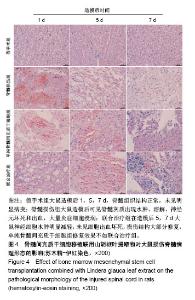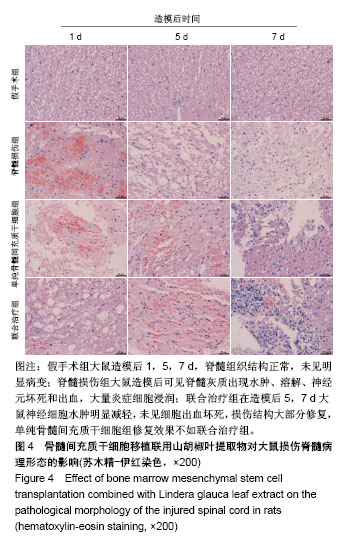Chinese Journal of Tissue Engineering Research ›› 2019, Vol. 23 ›› Issue (13): 1975-1981.doi: 10.3969/j.issn.2095-4344.1681
Previous Articles Next Articles
Bone marrow mesenchymal stem cell transplantation combined with Lindera glauca leaf extract attenutes inflammation after spinal cord injury
Cheng Jianping, Li Hua, Li Xiongjie
- Second Ward of Orthopedics, Hainan Western Central Hospital, Danzhou 571700, Hainan Province, China
-
Revised:2018-12-20Online:2019-05-08Published:2019-05-08 -
About author:Cheng Jianping, Associate chief physician, Second Ward of Orthopedics, Hainan Western Central Hospital, Danzhou 571700, Hainan Province, China -
Supported by:the Natural Science Foundation of Hainan Province, China, No. 818MS165 (to CJP)
CLC Number:
Cite this article
Cheng Jianping, Li Hua, Li Xiongjie. Bone marrow mesenchymal stem cell transplantation combined with Lindera glauca leaf extract attenutes inflammation after spinal cord injury[J]. Chinese Journal of Tissue Engineering Research, 2019, 23(13): 1975-1981.
share this article
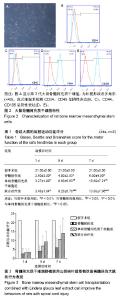
2.1 骨髓间充质干细胞特性 第3代大鼠骨髓间充质干细胞为长梭形或者多角形,呈平行排列或漩涡样生长;采用流式细胞仪检测骨髓间充质干细胞表面标志物显示CD44、CD105呈阳性表达,CD34、CD45呈阴性表达,见图2。 2.2 实验动物数量分析 SD大鼠造模后2 h左右清醒,表现为下肢基本瘫痪,仅前肢可运动,BBB评分均在10分以内,剔除大于10分者。脊髓损伤组1只大鼠死亡;脊髓损伤组、单纯骨髓间充质干细胞组、联合治疗组各有1只大鼠BBB评分>10分。最终保证每组均有12只大鼠进入结果分析。 2.3 各组大鼠的后肢运动功能评分 与假手术组相比,脊髓损伤组大鼠BBB评分明显降低(P < 0.01)。与脊髓损伤组相比,单纯骨髓间充质干细胞组、联合治疗组大鼠后肢功能开始逐渐恢复,BBB评分在造模后5,7 d有所上升(P < 0.05或P < 0.01)。联合治疗组造模后5,7 d的BBB评分明显高于单纯骨髓间充质干细胞组(P < 0.05)。具体见表1,图3。"
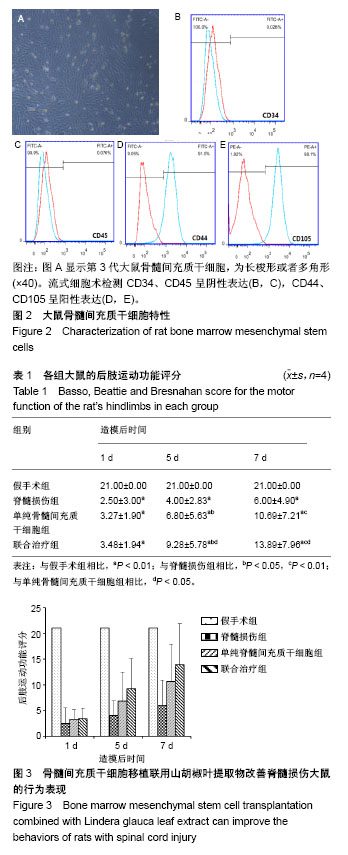
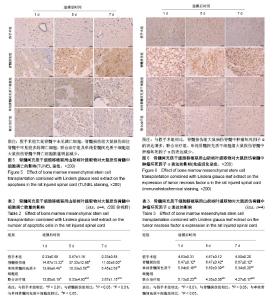
2.5 各组大鼠损伤脊髓中细胞凋亡情况 TUNEL染色结果显示,假手术组大鼠脊髓中未见凋亡细胞;脊髓损伤组大鼠损伤部位脊髓中可见较多的凋亡细胞;与模型组相比,联合治疗组及单纯骨髓间充质干细胞组大鼠损伤脊髓中凋亡细胞数量明显减少(P < 0.01或P < 0.05),且与单纯骨髓间充质干细胞组相比,联合治疗组大鼠损伤脊髓中凋亡细胞数量较少(P < 0.05),见图5,表2。 2.6 各组大鼠损伤脊髓中肿瘤坏死因子α的表达 免疫组化染色结果显示,肿瘤坏死因子α主要表达于胞浆或呈分泌型表达,呈褐色或黄褐色。与假手术组相比,脊髓损伤组大鼠损伤脊髓中肿瘤坏死因子α表达增加(P < 0.05);而与脊髓损伤组相比,联合治疗组、单纯骨髓间充质干细胞组大鼠损伤脊髓中肿瘤坏死因子α表达下降(P < 0.05),且联合治疗组大鼠损伤脊髓中肿瘤坏死因子α的表达水平低于单纯骨髓间充质干细胞组(P < 0.05),见图6,表3。 "

| [1] McDonald JW, Sadowsky C.Spinal-cord injury. Lancet. 2002;359 (9304): 417-425.[2] Sabapathy V, Tharion G, Kumar S. Cell Therapy Augments Functional Recovery Subsequent to Spinal Cord Injury under Experimental Conditions. Stem Cells Int. 2015;2015:132172.[3] Wang L, Wang Q, Zhang XM. Progress on bone marrow mesenchymal stem cells transplantation for spinal cord injury. Zhongguo Gu Shang. 2014;27(5):437-440.[4] Rasini V, Dominici M, Kluba T, et al. Mesenchymal stromal/stem cells markers in the human bone marrow. Cytotherapy. 2013;15(3): 292-306.[5] Tang C, Jin C, Du X, et al. An autologous bone marrow mesenchymal stem cell-derived extracellular matrix scaffold applied with bone marrow stimulation for cartilage repair. Tissue Eng Part A. 2014;20(17-18):2455-2462.[6] Han D, Wu C, Xiong Q, et al. Anti-inflammatory Mechanism of Bone Marrow Mesenchymal Stem Cell Transplantation in Rat Model of Spinal Cord Injury. Cell Biochem Biophys. 2015;71(3):1341-1347.[7] Jia Y, Wu D, Zhang R, et al. Bone marrow-derived mesenchymal stem cells expressing the Shh transgene promotes functional recovery after spinal cord injury in rats. Neurosci Lett. 2014;573: 46-51.[8] Cantinieaux D, Quertainmont R, Blacher S, et al. Conditioned medium from bone marrow-derived mesenchymal stem cells improves recovery after spinal cord injury in rats: an original strategy to avoid cell transplantation. PLoS One. 2013;8(8):e69515.[9] 孙慧玲,王俊霞,顾雪竹,等.山胡椒叶及果实挥发性成分分析[J].中国实验方剂学杂志,2011,17(7):94-97.[10] 张嘉穗,孔琳,雷洁萍,等.四川山胡椒叶抗氧化作用研究[J].现代中药研究与实践,2015,29(6):29-30,33.[11] 孔琳.绒毛山胡椒和四川山胡椒叶挥发油提取及活性研究[D].成都:西南交通大学,2014.[12] Stanko P, Kaiserova K, Altanerova V, et al. Comparison of human mesenchymal stem cells derived from dental pulp, bone marrow, adipose tissue, and umbilical cord tissue by gene expression. Biomed Pap Med Fac Univ Palacky Olomouc Czech Repub. 2014; 158(3):373-377.[13] Lee WJ, Hah YS, Ock SA, et al. Cell source-dependent in vivo immunosuppressive properties of mesenchymal stem cells derived from the bone marrow and synovial fluid of minipigs. Exp Cell Res. 2015; 333(2):273-288.[14] Song K, Huang M, Shi Q, et al. Cultivation and identification of rat bone marrow-derived mesenchymal stem cells. Mol Med Rep. 2014; 10(2): 755-760.[15] Ye J, Gong P, Zhou F, et al. Culture and identification of human bone marrow mesenchymal stem cells from alveolar ridge dental implant site. J Craniofac Surg. 2013;24(5):1539-1543.[16] Chen XZ, Zhang JY, Zeng JY, et al. Differentiation of rat bone marrow mesenchymal stem cells into adipocytes and blockage of the differentiation. Zhonghua Zhong Liu Za Zhi. 2012;34(11): 826-830.[17] Hu JZ, Long H, Wu TD, et al. The effect of estrogen-related receptor α on the regulation of angiogenesis after spinal cord injury. Neuroscience. 2015;290:570-580. [18] Basso DM, Beattie MS, Bresnahan JC. A sensitive and reliable locomotor rating scale for open field testing in rats. J Neurotrauma. 1995;12(1): 1-21.[19] Li G, Yu F, Lei T, et al. Bone marrow mesenchymal stem cell therapy in ischemic stroke: mechanisms of action and treatment optimization strategies. Neural Regen Res. 2016;11(6):1015-1024.[20] Zemel'ko VI, Kozhukharova IV, Kovaleva ZV, et al. BDNF secretion in human mesenchymal stem cells isolated from bone marrow, endometrium and adipose tissue. Tsitologiia. 2014;56(3):204-211.[21] Jeong CH, Kim SM, Lim JY, et al. Mesenchymal stem cells expressing brain-derived neurotrophic factor enhance endogenous neurogenesis in an ischemic stroke model. Biomed Res Int. 2014;2014:129145.[22] Wei L, Fraser JL, Lu ZY, et al. Transplantation of hypoxia preconditioned bone marrow mesenchymal stem cells enhances angiogenesis and neurogenesis after cerebral ischemia in rats. Neurobiol Dis. 2012;46(3): 635-645.[23] Hao L, Hao J, Fang W, et al. Dual isotope simultaneous imaging to evaluate the effects of intracoronary bone marrow-derived mesenchymal stem cells on perfusion and metabolism in canines with acute myocardial infarction. Biomed Rep. 2015;3(4):447-452.[24] Ramalho BDS, Almeida FM, Sales CM, et al.Injection of bone marrow mesenchymal stem cells by intravenous or intraperitoneal routes is a viable alternative to spinal cord injury treatment in mice. Neural Regen Res. 2018;13(6):1046-1053.[25] 刘立鼎,顾静文,陈京达.山胡椒叶子化学成分及其应用[J].江西科学, 1992(1): 38-44.[26] 张荣玉,赵德化,盛宝恒.山胡椒等三种中药挥发油的药理观察[J].第四军医大学学报,1985(3):200-204,273-274.[27] 王玉兰,高贤明,余孝平,等.我国山胡椒资源及其开发利用的研究[J].河南科学,1994(4):331-334.[28] Schültke E, Kendall E, Kamencic H, et al. Quercetin promotes functional recovery following acute spinal cord injury. J Neurotrauma. 2003;20(6): 583-591.[29] Fu J, Sun H, Zhang Y, et al. Neuroprotective Effects of Luteolin Against Spinal Cord Ischemia-Reperfusion Injury by Attenuation of Oxidative Stress, Inflammation, and Apoptosis. J Med Food. 2018; 21(1):13-20.[30] 陈秉耀,游思维,刘惠玲,等.Tarlov及BBB运动功能评估体系的比较[J].中华外科杂志,2002,40(3):236.[31] 陈向荣,游思维,金大地.BBB评分评估脊髓损伤大鼠后肢运动功能的探讨[J].中国脊柱脊髓杂志,2004,14(9):547-549.[32] 于德水,吕刚,梅晰凡,等.骨髓基质细胞移植对大鼠脊髓损伤后神经细胞凋亡的影响[J].辽宁医学院学报, 2009,30(2):100-101,159,[33] 吴永超,郑启新,谢宗平,等.骨髓间充质干细胞表达神经营养因子及治疗脊髓损伤的研究[J].中华实验外科杂志, 2005,22(2):139-141. [34] Cizkova D, Cubinkova V, Smolek T, et al. Localized Intrathecal Delivery of Mesenchymal Stromal Cells Conditioned Medium Improves Functional Recovery in a Rat Model of Spinal Cord Injury. Int J Mol Sci. 2018;19(3): E870.[35] Pu Y, Meng K, Gu C, et al. Thrombospondin-1 modified bone marrow mesenchymal stem cells (BMSCs) promote neurite outgrowth and functional recovery in rats with spinal cord injury. Oncotarget. 2017; 8(56):96276-96289.[36] Ciccarelli F, De Martinis M, Sirufo MM, et al. Psoriasis Induced by Anti-Tumor Necrosis Factor Alpha Agents: A Comprehensive Review of the Literature. Acta Dermatovenerol Croat. 2016;24(3):169-174.[37] Cordero-Coma M, Sobrin L. Anti-tumor necrosis factor-α therapy in uveitis. Surv Ophthalmol. 2015;60(6):575-589.[38] Peng RJ, Jiang B, Ding XP, et al. Effect of TNF-α Inhibition on Bone Marrow-Derived Mesenchymal Stem Cells in Neurological Function Recovery after Spinal Cord Injury via the Wnt Signaling Pathway in a Rat Model. Cell Physiol Biochem. 2017;42(2):743-752.[39] Yang XM, Cheng YY, Zhang ZL, et al. Role of Methylprednisolone in Treatment of Spinal Cord Injured with Bone Marrow Mesenchymal Stem Cells Transplantation in Rats and Its Effect on the Expressions of Tumor Necrosis Factor-α and Interleukin-1β. Zhongguo Yi Xue Ke Xue Yuan Xue Bao. 2017;39(5):615-622.[40] 康聪,孟宪勇,杨新明,等.小剂量雌激素肌肉注射联合骨髓间充质干细胞移植修复脊髓损伤[J].中国组织工程研究, 2017,21(25):4020-4025.[41] Li J, Guo W, Xiong M, et al. Effect of SDF-1/CXCR4 axis on the migration of transplanted bone mesenchymal stem cells mobilized by erythropoietin toward lesion sites following spinal cord injury. Int J Mol Med. 2015;36(5):1205-1214. |
| [1] | Lin Qingfan, Xie Yixin, Chen Wanqing, Ye Zhenzhong, Chen Youfang. Human placenta-derived mesenchymal stem cell conditioned medium can upregulate BeWo cell viability and zonula occludens expression under hypoxia [J]. Chinese Journal of Tissue Engineering Research, 2021, 25(在线): 4970-4975. |
| [2] | Pu Rui, Chen Ziyang, Yuan Lingyan. Characteristics and effects of exosomes from different cell sources in cardioprotection [J]. Chinese Journal of Tissue Engineering Research, 2021, 25(在线): 1-. |
| [3] | Zhang Tongtong, Wang Zhonghua, Wen Jie, Song Yuxin, Liu Lin. Application of three-dimensional printing model in surgical resection and reconstruction of cervical tumor [J]. Chinese Journal of Tissue Engineering Research, 2021, 25(9): 1335-1339. |
| [4] | Wang Xianyao, Guan Yalin, Liu Zhongshan. Strategies for improving the therapeutic efficacy of mesenchymal stem cells in the treatment of nonhealing wounds [J]. Chinese Journal of Tissue Engineering Research, 2021, 25(7): 1081-1087. |
| [5] | Wang Shiqi, Zhang Jinsheng. Effects of Chinese medicine on proliferation, differentiation and aging of bone marrow mesenchymal stem cells regulating ischemia-hypoxia microenvironment [J]. Chinese Journal of Tissue Engineering Research, 2021, 25(7): 1129-1134. |
| [6] | Zeng Yanhua, Hao Yanlei. In vitro culture and purification of Schwann cells: a systematic review [J]. Chinese Journal of Tissue Engineering Research, 2021, 25(7): 1135-1141. |
| [7] | Kong Desheng, He Jingjing, Feng Baofeng, Guo Ruiyun, Asiamah Ernest Amponsah, Lü Fei, Zhang Shuhan, Zhang Xiaolin, Ma Jun, Cui Huixian. Efficacy of mesenchymal stem cells in the spinal cord injury of large animal models: a meta-analysis [J]. Chinese Journal of Tissue Engineering Research, 2021, 25(7): 1142-1148. |
| [8] | Hou Jingying, Yu Menglei, Guo Tianzhu, Long Huibao, Wu Hao. Hypoxia preconditioning promotes bone marrow mesenchymal stem cells survival and vascularization through the activation of HIF-1α/MALAT1/VEGFA pathway [J]. Chinese Journal of Tissue Engineering Research, 2021, 25(7): 985-990. |
| [9] | Shi Yangyang, Qin Yingfei, Wu Fuling, He Xiao, Zhang Xuejing. Pretreatment of placental mesenchymal stem cells to prevent bronchiolitis in mice [J]. Chinese Journal of Tissue Engineering Research, 2021, 25(7): 991-995. |
| [10] | Liang Xueqi, Guo Lijiao, Chen Hejie, Wu Jie, Sun Yaqi, Xing Zhikun, Zou Hailiang, Chen Xueling, Wu Xiangwei. Alveolar echinococcosis protoscolices inhibits the differentiation of bone marrow mesenchymal stem cells into fibroblasts [J]. Chinese Journal of Tissue Engineering Research, 2021, 25(7): 996-1001. |
| [11] | Fan Quanbao, Luo Huina, Wang Bingyun, Chen Shengfeng, Cui Lianxu, Jiang Wenkang, Zhao Mingming, Wang Jingjing, Luo Dongzhang, Chen Zhisheng, Bai Yinshan, Liu Canying, Zhang Hui. Biological characteristics of canine adipose-derived mesenchymal stem cells cultured in hypoxia [J]. Chinese Journal of Tissue Engineering Research, 2021, 25(7): 1002-1007. |
| [12] | Geng Yao, Yin Zhiliang, Li Xingping, Xiao Dongqin, Hou Weiguang. Role of hsa-miRNA-223-3p in regulating osteogenic differentiation of human bone marrow mesenchymal stem cells [J]. Chinese Journal of Tissue Engineering Research, 2021, 25(7): 1008-1013. |
| [13] | Lun Zhigang, Jin Jing, Wang Tianyan, Li Aimin. Effect of peroxiredoxin 6 on proliferation and differentiation of bone marrow mesenchymal stem cells into neural lineage in vitro [J]. Chinese Journal of Tissue Engineering Research, 2021, 25(7): 1014-1018. |
| [14] | Zhu Xuefen, Huang Cheng, Ding Jian, Dai Yongping, Liu Yuanbing, Le Lixiang, Wang Liangliang, Yang Jiandong. Mechanism of bone marrow mesenchymal stem cells differentiation into functional neurons induced by glial cell line derived neurotrophic factor [J]. Chinese Journal of Tissue Engineering Research, 2021, 25(7): 1019-1025. |
| [15] | Duan Liyun, Cao Xiaocang. Human placenta mesenchymal stem cells-derived extracellular vesicles regulate collagen deposition in intestinal mucosa of mice with colitis [J]. Chinese Journal of Tissue Engineering Research, 2021, 25(7): 1026-1031. |
| Viewed | ||||||
|
Full text |
|
|||||
|
Abstract |
|
|||||
